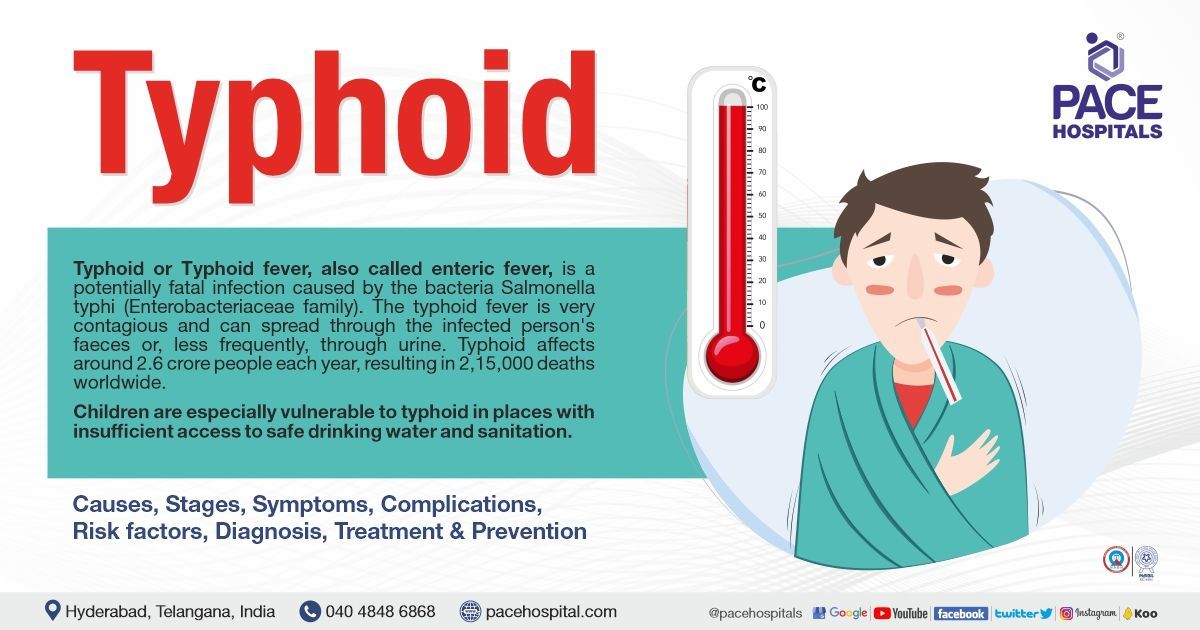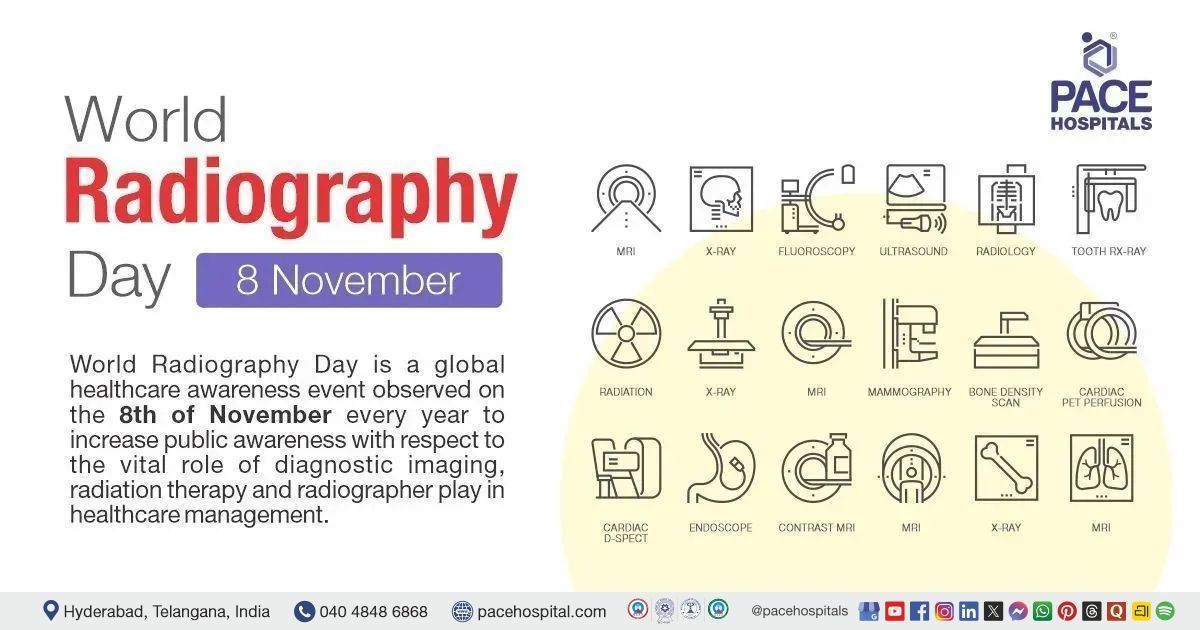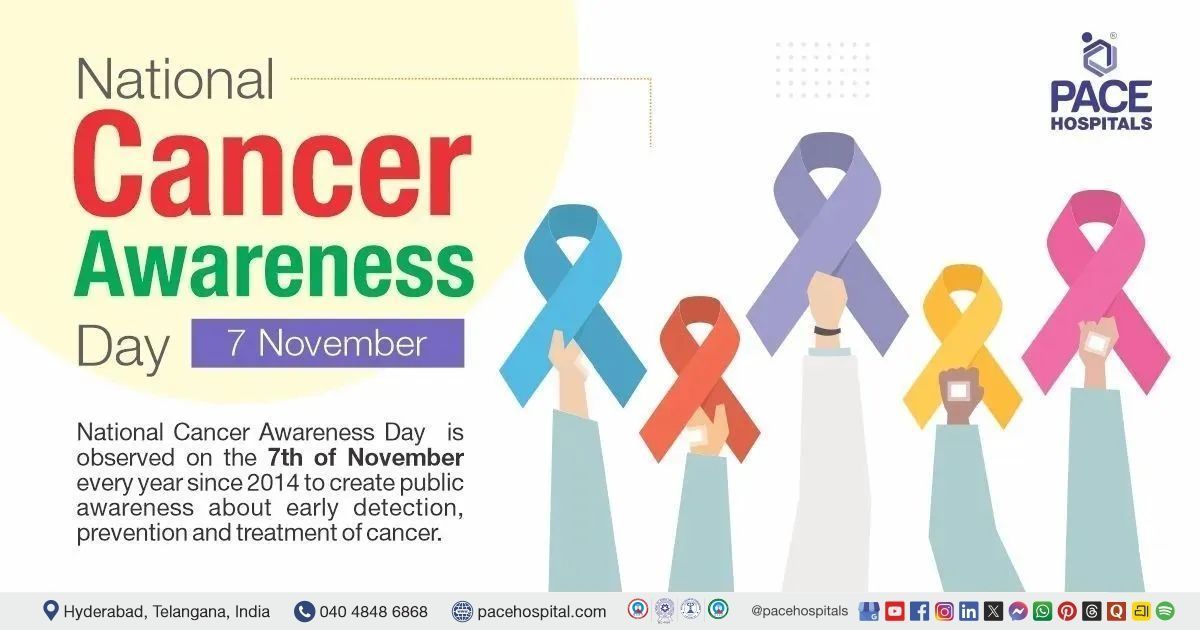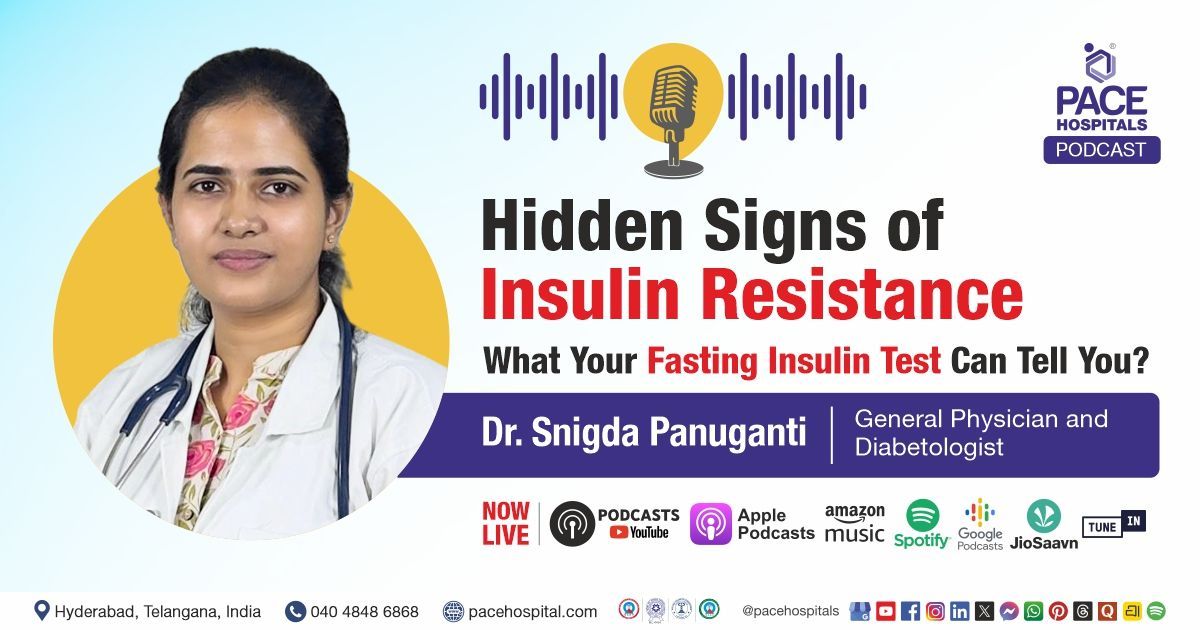Typhoid Fever – Symptoms, Causes, Risk Factors, Complications & Prevention
Pace Hospitals
Typhoid definition
Typhoid or typhoid fever, also called enteric fever, a fatal infection caused by the bacteria Salmonella typhi (Enterobacteriaceae family). This multi systemic disease has historically been a burden for public health, particularly in underdeveloped nations. The typhoid fever is very contagious and can spread through the infected person's faeces or, less frequently, through urine.
Typhoid fever is one of the main causes of mortality and morbidity in overpopulated and unhygienic areas, despite substantial research and public health initiatives. According to WHO (World Health Organization), Typhoid affects around 2.6 crore people yearly, resulting in 2,15,000 deaths worldwide. Children are especially vulnerable to typhoid in places with the unavailability of safe drinking water and sanitation.
Typhoid causes
Typhoid fever causes are more common in locations with overcrowding, social chaos, and inadequate sanitation, as Salmonella enterica serovar Typhi (Salmonella typhi) spreads through the faecal-oral route via contaminated water, undercooked foods, and fomites (objects that carry infection) of infected patients.
Since humans are its only host, typhoid spreads from one infected person to another or via carriers such as houseflies or typhoid carriers (typhoid recovers), which carry bacteria in their bodies.
Salmonella typhi (S. typhi) is usually released into the faeces (rarely in urine) of the diseased or infected person and spreads by one of the following:
- Unhygienic practise (unclean hands) of an infected person after using the washroom and preparing food without washing hands, shaking hands with healthy persons, or touching areas where a healthy person can access.
- Practise defecating in open areas where carriers (houseflies) aid in transferring the disease-causing organism from the faeces to the consumables or eatables.
- Infectious human faeces can contaminate water sources in areas with poor sanitation. Typhoid fever can be contracted by drinking or consuming food washed with contaminated water.
The other methods by which typhoid spreads are:
- Consuming seafood that has been exposed to contaminated water or human waste
- Consuming uncooked vegetables that have been fertilised with human waste
- Sexual contact (anal) with Salmonella typhi bacteria carrier
Pathogenesis of typhoid
Salmonella bacteria invade the small intestine for a certain time (temporarily) and enter the bloodstream after being ingested through contaminated food or water. These are carried by white blood cells to the spleen, liver and bone marrow, where the bacteria grow and are reabsorbed back into the bloodstream.
At this point, fever and other symptoms start appearing in infected patients. Through the bloodstream, Salmonella invades the biliary system, gallbladder, and lymphatic tissue of the bowel and quickly multiplies in large numbers. These bacteria are then detected in faeces samples after they have entered the intestines.
Typhoid stages
There are four stages of typhoid fever, and each step might last for one week. The typhoid incubation period usually takes 7–14 days after ingestion of S. typhi. The stages are as follows:
- First stage
- Second stage
- Third stage
- Fourth stage
First stage: The patient exhibits some early typhoid symptoms during this stage (first week), such as abdominal pain (right upper), difficult-to-pass stools, dry cough, delirium, stupor, malaise and dull headache. Each day, the temperature rises and then falls by the following morning. Over time, the temperature gradually increases.
Second stage: In this stage (second week), there will be a progression of first-stage symptoms, such as
- Body temperature rises to 102 to 104 degrees Fahrenheit
- Abdominal swelling
- The appearance of rose spots on the chest, back and abdomen might resolve in 2-5 days
Third stage: This is the serious stage, where the patient may experience the following
- Decreases in weight
- Conjunctivitis (inflammation of the conjunctiva)
- Tachypnea (increased breathing)
- Increase in toxaemia (increased toxins in the blood)
- Anorexia (reduced food intake)
- Crackling sound from the base of the lungs
- Severe abdominal distension
- Liquid diarrhoea (foul, green-yellow)
- Increase delirium's intensity
- Bowel perforation and peritonitis can develop as a result of necrosis in Peyer's patches (tiny lymphoid organs located in the small intestine's wall).
- Death may occur due to severe toxaemia, myocarditis or intestinal bleeding.
Fourth stage: Extremely high fever is the defining feature of this typhoid stage.
- Over a few days, the fever, mental state, and abdominal discomfort gradually improved.
- Patients who are not treated could develop intestinal and neurological issues.
- Loss of weight and extreme weakness (may last for months)
- Some patients with an asymptomatic carrier condition can continue transmitting the bacterium.
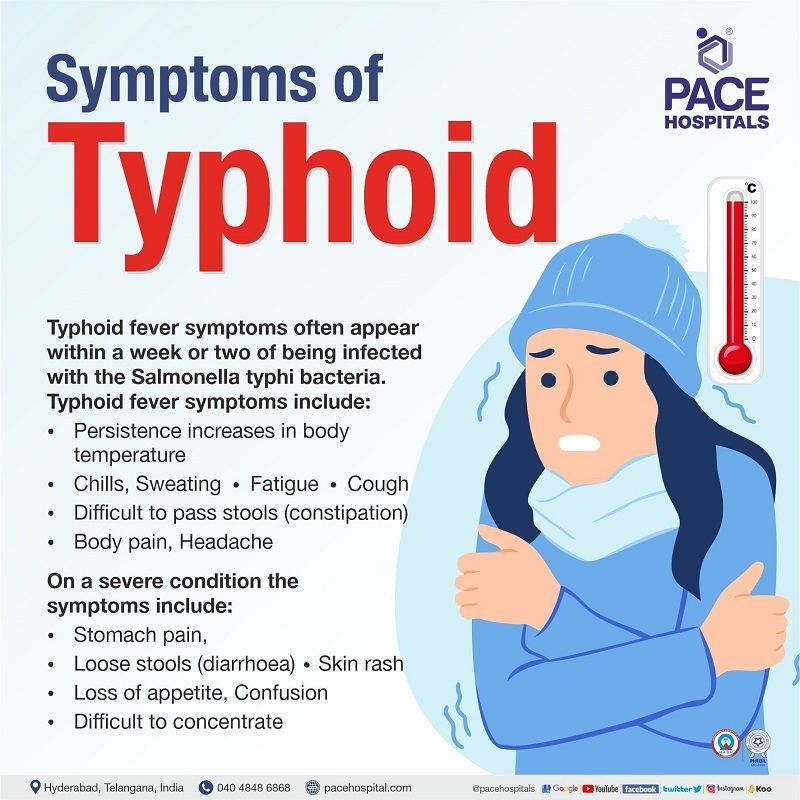
Symptoms of typhoid fever
Typhoid fever symptoms often appear within a week or two of being infected with the Salmonella typhi bacteria. With therapy, typhoid fever symptoms should begin to subside within 3–5 days. Untreated typhoid fever often worsens over the course of a few weeks and can lead to potentially fatal complications. The typhoid symptoms in kids are similar to those in adults.
Typhoid fever symptoms include:
- Persistence increases in body temperature
- Chills
- Sweating
- Fatigue
- Cough
- Difficult to pass stools (constipation)
- Body pain
- Headache
- On a severe condition, the symptoms include:
- Stomach pain
- Loose stools (diarrhoea)
- Skin rash
- Loss of appetite
- Confusion
- Difficult to concentrate
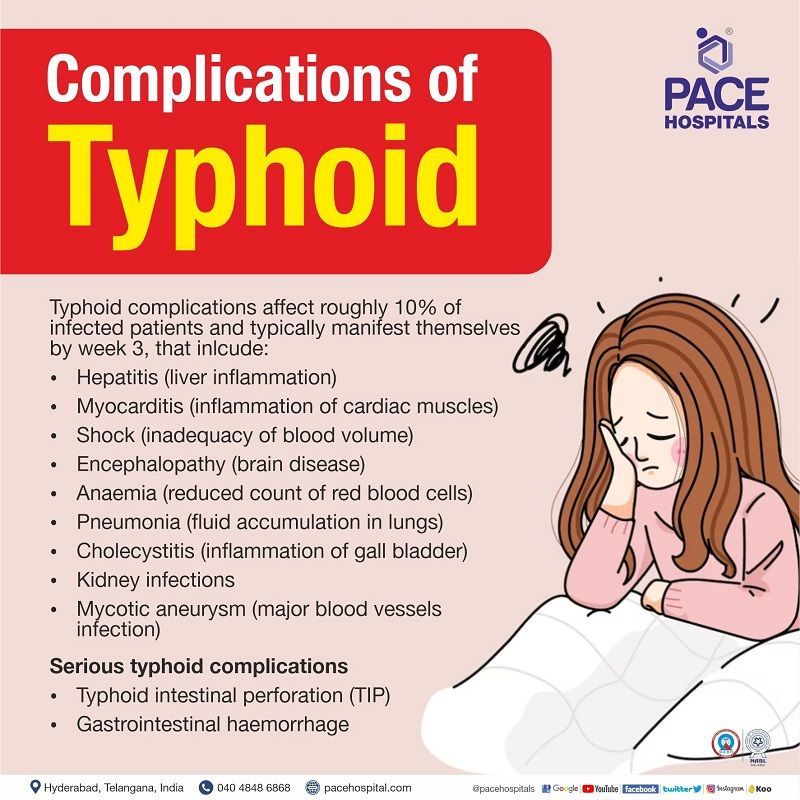
Complications of typhoid fever
Typhoid complications affect roughly 10% of infected patients and typically manifest themselves by week 3. To prevent hospitalisation and mortality, typhoid fever must be diagnosed and treated promptly in the community. The absence of such might lead to the following typhoid complications:
- Hepatitis (liver inflammation)
- Myocarditis (inflammation of cardiac muscles)
- Shock (inadequacy of blood volume)
- Encephalopathy (brain disease)
- Anaemia (reduced count of red blood cells)
- Pneumonia (fluid accumulation in lungs)
- Cholecystitis (inflammation of gall bladder)
- Kidney infections
- Mycotic aneurysm (major blood vessels infection)
- Serious typhoid complications include
- Typhoid intestinal perforation (TIP)
- Gastrointestinal haemorrhage
A typhoid intestinal perforation could be a life-threatening scenario, as the intestinal bacteria (present in the intestine) migrate into the stomach and infect the abdominal lining (the peritoneum), leading to inflammation of the abdomen (peritoneum). In this condition, the infection spreads into the blood, resulting in sepsis before spreading to other organs (multiple organ failure).
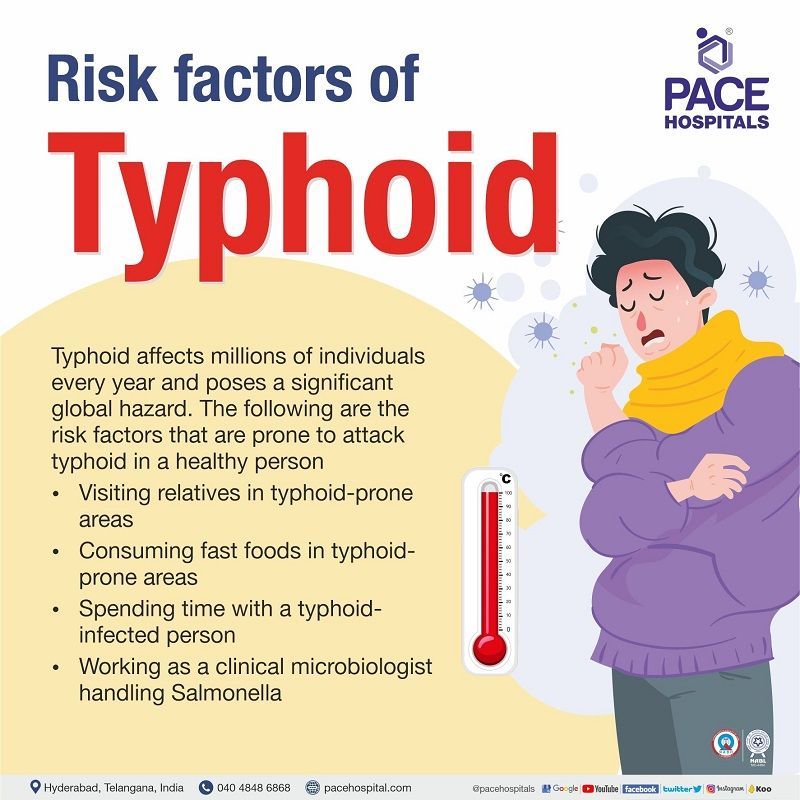
Risk factors of typhoid fever
Typhoid affects millions of individuals every year and poses a significant hazard globally. Instances are reported everywhere, and travellers from the outbreak regions are the main sources of spread.
- Visiting relatives in typhoid-prone areas
- Consuming fast foods in typhoid-prone areas
- Spending time with a typhoid-infected person
- Working as a clinical microbiologist handling Salmonella
Typhoid diagnosis
Patients who have been diseased for more than three days with a fever and gastrointestinal symptoms (pain, constipation, or diarrhoea) live in places with inadequate sanitation or access to clean drinking water, or who have travelled to endemic areas are at high risk. Typhoid fever diagnosis in the first week is challenging, although many laboratory procedures can help narrow down the possibilities.
The general physician (GP) will examine the patient's signs and symptoms and inquire about the patient's travel history, area of residence and hygiene status. Post that, the general physician may prescribe one of the following typhoid fever diagnostic tests (typhoid test) as:
- Body fluid or tissue culture
- Widal test
- Skin snip test
- Polymerase chain reaction (PCR) Assay
- Enzyme-Linked Immunosorbent Assay (ELISA)
Body fluid or tissue culture: The blood test for typhoid generally involves sample collection of the infected person's stool, bone marrow and blood culture test for typhoid detection. These samples will be cultured by providing them with necessary bacteria growth factors. The growth area will be examined under the microscope for the presence of Salmonella typhi.
- Bone marrow test is considered as most standard one than blood and stool tests; however, it is the most painful and time taking procedure.
- High-volume samples are needed for blood culture, which increases its effectiveness.
- In the second and third weeks, stool cultures serve as diagnostic tests. The volume of stool samples collected and the severity of the sickness affects the sensitivity of the stool culture.
Widal test: The Widal test for typhoid was developed more than a century ago and is still among the most popular diagnostic tests in use today for typhoid detection, but it has severe limitations in terms of sensitivity and specificity. The Widal test finds agglutinating antibodies against Salmonella typhi’s O and H antigens. This test is suggested in the second week of infection when the level of the homologous antibodies in the serum is at its peak.
The test consists of the slide method or tube method, where the patient’s serum sample will be mixed with Salmonella typhi’s O and H antigens. If the patient is infected with Salmonella typhi, the homologous antibodies in the serum react with the O and H antigens, forming agglutination or lump. Typhoid infection is indicated by the Widal test, where the antibody titer range is more than or equal to 1:80 for antigen O and 1:160 titre for antigen H.
Skin snip test: It is a rare type of test where skin snip cultures taken from rose spots have yielded positive results.
Polymerase chain reaction (PCR) Assay: Several DNA-based serotypes, including the H antigen gene and the O antigen gene, can be identified by Polymerase Chain Reaction (PCR). However, sensitivities may be low due to low bacterial concentrations during bacteraemia.
Enzyme-Linked Immunosorbent Assay (ELISA): Acute disease rarely benefits from ELISA's ability to detect antibodies to the capsular polysaccharide Vi antigens, while it may be useful for identifying carriers.
Typhoid treatment
A course of antibiotic medication can typically successfully treat typhoid fever. The intensity, length, spread, and consequences of the disease all influence the typhoid fever treatment strategy. After examining diagnostic reports, and if the tests indicate the presence of Salmonella typhi at an early stage, the general physician might prescribe appropriate antibiotics (based on the sensitivity report) for one to two weeks. The patient's symptoms should improve (recover from symptoms) within three days of taking antibiotics.
Typhoid perforation surgery
Peritonitis frequently results from intestinal perforation, requiring immediate surgical care. In severe circumstances, Salmonella typhi infection might result in intestinal perforation, necessitating immediate surgery.
The surgical procedure includes closure of perforation with peritoneal draining (draining fluid from the peritoneal cavity). Patients with multiple perforations require small-bowel resection. The gallbladder will be removed if antibiotic treatment fails to eliminate the hepatobiliary carriage completely.
Surgical complications of typhoid fever:
The most common surgical complications include:
- Intestinal perforation
- Intestinal bleeding
- Cholecystitis (inflammation of gall bladder)
- Osteomyelitis (inflammation of bone or bone marrow)
- Abscesses
Home remedies for typhoid fever
The infection can typically be treated at home, but if it's serious, the patient might need to be admitted to the hospital. The following home remedies can aid in quick recovery from typhoid fever:
- Consuming soluble fibre-rich fruits to curb diarrhoea
- Consuming Ocimum sanctum (Tulasi) water for its wide antibacterial property
- Consuming plenty of fluids to avoid electrolyte imbalance
- Adhering to prescribed medication
Prevention of typhoid fever
The following can aid in preventing typhoid fever
- Drinking safe and hygienic water
- Washing hands thoroughly before initiation of cooking and eating
- Timely vaccination
- Goodhand hygiene practice in typhoid infected person
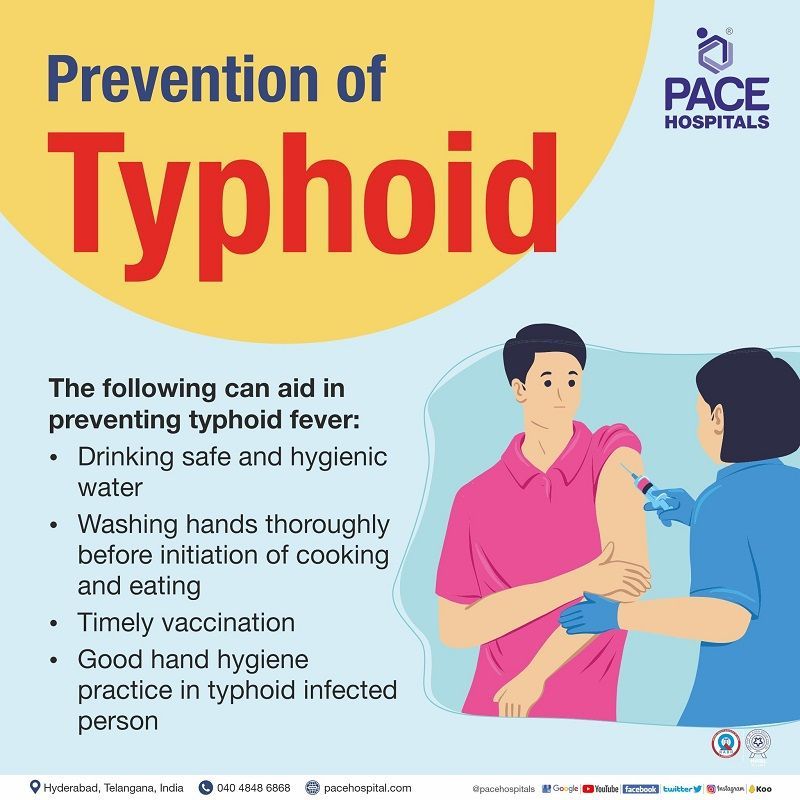
Typhoid vaccine
Two vaccinations can prevent typhoid fever. Depending on the age, vaccines are administered.
- Live, attenuated (weakened) vaccine
- Inactivated (dead) vaccine
Live, attenuated (weakened) vaccine: It is consumed orally (by mouth) and given to children (over six years old) and adults. The total dose is four capsules; one capsule per day should be taken every alternate day. It should be swallowed an hour before meals with cold or lukewarm water. At least a week before travel, the last dose should be taken. For those who are at risk, a booster shot is required every five years. It's crucial to store vaccine capsules in a refrigerator (not frozen).
Inactivated (dead) vaccine: This is a typhoid vaccine for babies (age over two years), administered through injection (typhoid injection). One dose is advised at least two weeks before travel. For those who are continued to be at risk, repeated doses every two years are advised.
Frequently asked questions
Share on
Request an appointment
Fill in the appointment form or call us instantly to book a confirmed appointment with our super specialist at 04048486868

